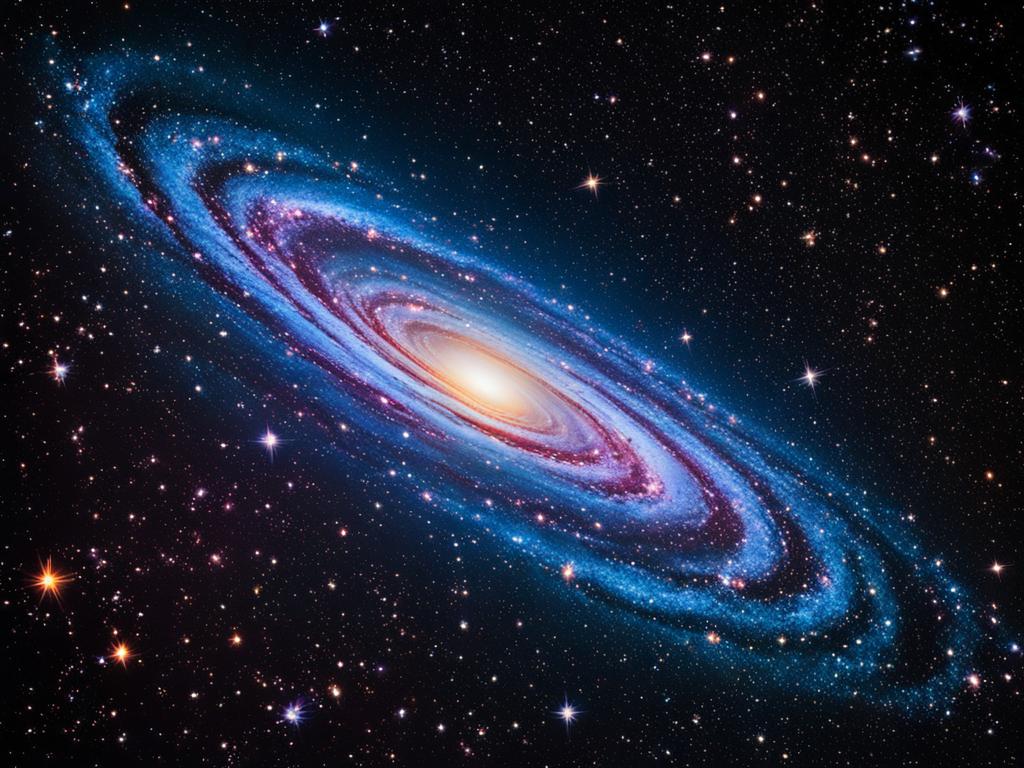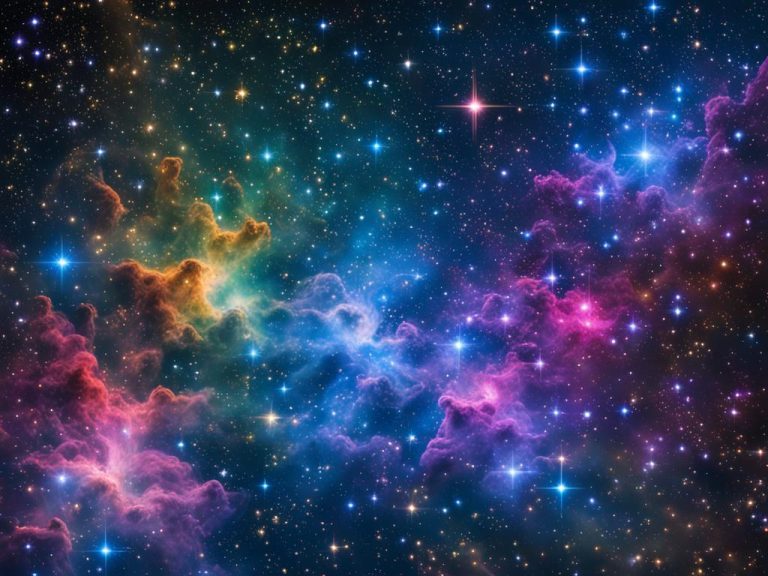Explore the Wonders of Tucana Constellation
Did you know the Tucana Constellation hides secrets from thousands of years ago? It’s located far in the south sky. This small yet strong group of stars amazes people with its beauty and stories.
For anyone who loves looking at the stars, Tucana is perfect. It’s full of interesting history, bright stars, and myths. Exploring Tucana takes you on an amazing journey through space.

Key Takeaways:
- Located in the southern sky, the Tucana Constellation is a small yet prominent constellation that has intrigued astronomers for centuries.
- Tucana offers a mesmerizing display of stars and deep-sky objects, making it a must-see for astronomy enthusiasts in the Southern Hemisphere.
- Explore the rich history and mythology surrounding Tucana to gain a deeper appreciation for this fascinating constellation.
- Consider naming a star in Tucana as a timeless and unique gift for someone special through International Star Registry.
- Discover the wonders of the Small Magellanic Cloud, a neighboring galaxy visible from Tucana, and unlock its secrets of stellar nurseries and open star clusters.
Introduction to the Tucana Constellation
Welcome to the amazing Constellation Tucana! It’s in the southern sky. Tucana is a small but important group of stars. It has been loved by those who look up at the night sky. So, if you enjoy watching stars, Tucana is full of wonders for you.
The constellation got its name from a Dutch story. Dutch sailors Pieter Dirkszoon Keyser and Frederick de Houtman found it in the late 16th century. They thought the stars looked like a toucan bird. This bird is native to Brazil.
To enjoy Tucana, knowing the star map helps. A star map is like a road map for the sky. It shows you where the main stars and cool things are. With this map, you can start your adventure in Tucana. You’ll find many amazing things as you explore.
There are some cool facts about Tucana. It’s one of the 88 constellations known today. Three other constellations are near it: Phoenix, Grus, and Hydrus. This makes Tucana a special part of the night sky.
Now that you have the basics, let’s learn more about Tucana. We’ll talk about its stars, its history, and the stories people told about it. We may even share a cool gift idea related to Tucana. So, get ready for an adventure into Tucana’s magical world.
A Journey Through the Stars
We’re starting our trip with Tucana’s stars as our guides. We’ll see all sorts of things, from double stars to forming clouds. Tucana is waiting to show us its cosmic secrets. Get ready for an unforgettable view of the night sky.
Unveiling the Mythology
Every constellation comes with great stories, including Tucana. These stories are from long ago. They help us understand the stars better. Let’s explore the myths of Tucana. They add a special magic to looking at the stars.
We are all set for a magical journey through Tucana. We’ll learn about its myths and many interesting facts. Tucana has a lot to show us. So, let’s get started and be amazed!
Exploring the Stars of Tucana
The Tucana Constellation shows us a beautiful display of stars. Each one has its own special look. We will look closer at some famous stars in the Tucana star cluster.
Alpha Tucanae: The Brilliance Within
Alpha Tucanae shines the brightest in Tucana. It’s about 211 light-years from us. This star system’s glow is enjoyed by both astronomers and anyone who loves to look at stars.
Beta Tucanae: an Elegance in the Sky
Beta Tucanae is a yellow-white giant, looking elegant from 85 light-years away. Its brightness adds to Tucana’s beauty. It catches the eye of everyone who gazes into the sky at night.
Looking at the Tucana Constellation, you might feel like the stars are alive. They take you on a journey through a beautiful yet mysterious cosmos. These stars in the sky encourage us to find out more about the universe.
Keep exploring this cosmic story. We’ll learn about the interesting history and myths of the Tucana Constellation soon.
History and Mythology
The Tucana constellation comes from ancient stories. It’s tied to the toucan bird. In South American cultures, the toucan represents strength and adaptability. This makes Tucana special.
Its name, Tucana, comes from the Latin word for toucan. In 1603, Johann Bayer, a German, put Tucana in his star book Uranometria. This book included 51 constellations, all named after objects and animals.
Tucana isn’t famous for myths, but its place in the sky is well-loved. The stars form a toucan shape. This adds wonder to the night view.
For more about Tucana’s story, check these links:

Tucana’s link to myths and its view in the sky inspire many. Scientists and lovers of space find it fascinating. Its history and beauty are great for exploring and learning.
Naming a Star in Tucana: A Timeless Gift
With International Star Registry, you can name a star after someone in the Tucana Constellation for you or someone special. It’s a special and heartfelt gift for birthdays, Christmas, or anniversaries.
Go to starregistry.com to pick a star and get a fancy certificate with its new name. When you buy a star for someone, you give them a part of the galaxy. It shows your love and gratitude.
Just imagine their face when they see their star’s name on the personalized certificate. This gift makes them feel loved and unique.
By naming a star, you honor a loved one’s memory or mark their big achievements. It’s a gift that lasts forever and shows your deep feelings.
The Importance of Buying a Star
Looking for a special gift? Consider buying a star in the Tucana Constellation. It’s unique, and it lasts forever.
International Star Registry lets you name a star. They’ve been doing this for over 45 years. Millions have named a star with them.
A star makes a great gift anytime. Think birthdays, graduations, or just because. It’s a lasting memory in the Tucana Constellation.
The Perfect Gift
Naming a star after someone is special. It’s more than a star gift, it’s a tie to the heavens. Every night, they’ll remember you.
Discover the Small Magellanic Cloud
Exploring the Tucana constellation can lead you to the amazing Small Magellanic Cloud (SMC). It’s one of two large dwarf galaxies circling the Milky Way. Even though it’s 197,000 light-years away, it’s close in galactic terms.
For stargazers in the south, the Small Magellanic Cloud is a treat. It’s filled with clusters and nebulae that amaze. One example is NGC 346, a birthplace of stars. The SMC shows us the beauty of Southern Hemisphere stars.
In the Tucana sky, look out for 47 Tucanae, or NGC 104. It’s the Milky Way’s second brightest cluster. You can see it with just your eyes, looking as big as the full moon.
Opposite the 47 Tucanae, another gem awaits. NGC 362 is a 6th magnitude cluster on the SMC’s southern edge. It adds to the area’s charm.
The Hubble Deep Field South is also in Tucana. This famous photo shows a part of the Tucana constellation. It’s a proof of what amazing things we can find there.
Tucana and the SMC offer endless wonders for those who explore the night sky. It’s among the special southern constellations. A home to amazing celestial sights and weaving secrets of the universe.
Sources: earthsky.org, astromax.org, hubblesite.org
The Small Magellanic Cloud’s Stellar Nurseries
The Small Magellanic Cloud (SMC) is found in the Tucana Constellation. It is a stunning area where many new stars are born. A highlight is NGC 346, a star cluster at the SMC’s center. This cluster is lively, with a lot of new stars forming over about 200 light-years.
In NGC 346, stars start to form in clouds of gas and dust. These places act like a nursery for stars. The star-making starts when gravity pulls gas and dust together. This makes it hot and bright, forming a new star.
The SMC is a great place for scientists to watch stars being born. Dust makes the starlight look red, giving a unique color to the area. By using powerful telescopes, scientists learn a lot about how stars, including our Sun, begin.
The Stunning Beauty of NGC 346
Look at NGC 346’s amazing beauty in the image below:
The picture shows bright, young stars in NGC 346. It mixes with gas and dust, creating a stunning scene. This view highlights beauty in star creation.
Visiting the SMC nurseries lets us see the universe’s creation story. NGC 346’s view is more than artwork, it’s how new stars come to be. It’s a place in the sky worth marveling at.
The Small Magellanic Cloud’s Deep Skies
The Small Magellanic Cloud (SMC) in the Tucana Constellation is famous for its beautiful star formation areas. It’s also a home to many deep sky objects. One notable object is NGC 292, which is part of the SMC. This object can be seen without a telescope, showing off the SMC’s glory.
The SMC also boasts two bright globular clusters, NGC 104 and NGC 121. NGC 104, or 47 Tucanae, is a stunning sight in the night sky. It’s known for having thousands of stars, making it one of the best in our galaxy.
NGC 121 is another globular cluster in the outskirts of the Small Magellanic Cloud. It sparkles and adds to the amazing view of the SMC.
Exploring the SMC’s deep sky reveals a vast array of celestial wonders. Objects like NGC 292, NGC 104, and NGC 121 offer endless beauty to astronomers and anyone who loves the stars.
Come see the stunning deep skies of the Small Magellanic Cloud. It’s a chance to get lost in the mysteries of space.
The Open Star Clusters of Tucana
Tucana sits in the Small Magellanic Cloud and has its special open star clusters. NGC 265 and NGC 290 are two great examples. You can spot them like gems in the night sky using telescopes.
With a brightness of 12.0, NGC 265 pulls in both astronomers and casual viewers. It truly stands out in the Tucana Constellation, making the night sky more magical.
NGC 290 is equally impressive, covering about 65 light-years. It’s filled with stars that glisten in their own unique way. Placed in Tucana, it makes the constellation even more dazzling.
Take time to enjoy NGC 265 and NGC 290 when looking at the stars in Tucana. These clusters show just how beautiful and vast the universe is.

Let’s keep on exploring the wonders of the Tucana Constellation. There are still more exciting things to see in the Small Magellanic Cloud.
The Beauty of Tucana
Tucana isn’t as well-known as some constellations. Yet, it is truly beautiful and significant. It inspires awe in anyone, whether you’re an expert or just love looking at the stars.
The Tucana Constellation lives in the southern sky. It can be seen best from some specific places, like in South America and Antarctica. If you want to explore its stars and patterns, using a Tucana star map is a great idea.
Tucana has amazing things to see. It has big stars like Alpha Tucanae and Epsilon Tucanae. Plus, there are lovely open star clusters and nebulae. There’s always something interesting for both beginners and pros to find.
Especially stunning in Tucana is the Small Magellanic Cloud. This dwarf galaxy is 200,000 light-years away. It’s full of stars, nebulae, and other cool space stuff. Astronomers love studying it.
Seeing Tucana in the night sky is special. Its colorful stars and beautiful nebulae are truly a wonder. They remind us of the huge and amazing universe we live in.
Next time you look up at the stars, remember the beauty of Tucana. It’s not just pretty; it’s also full of things to learn and discover. Tucana will catch your eye and spark your curiosity.
Conclusion
Discover the wonders of the Tucana Constellation. It’s a captivating celestial gem that has fascinated astronomers for centuries. Tucana was shown to European observers by Dutch navigators in the late 16th century. Pieter Dirkszoon Keyser and Frederick de Houtman’s discovery brings a wealth of astronomical knowledge.
Alpha Tucanae shines brightly from 211 light-years away. Meanwhile, Beta Tucanae, a yellow-white giant star, is closer at only 85 light-years from Earth. These stars offer insights into the vastness of our universe.
Naming a star in the Tucana Constellation via International Star Registry is special. It marks an occasion and helps fund astronomical projects. These projects include telescope upgrades, educational programs, and outreach initiatives. Your named star can support the continuous exploration of space.
Explore the Small Magellanic Cloud within Tucana. This area is home to fascinating globular clusters. The Tucana Constellation, part of the ‘Southern Birds’ group, provides a pathway to endless knowledge and exploration.
FAQ
What is the Tucana Constellation?
The Tucana Constellation is a small group of stars in the southern sky. It’s easily seen in the south.
Who introduced the Tucana Constellation to European observers?
Dutch navigators named Pieter Dirkszoon Keyser and Frederick de Houtman showed it in the late 16th century.
What does the Tucana Constellation represent?
It looks like a toucan bird because of its bright stars and shape.
Where can I name a star in the Tucana Constellation?
On starregistry.com, you can find out how to name a star here.
What are some open star clusters in the Tucana Constellation?
NGC 265 and NGC 290 are two examples. They are known as open star clusters here.
Is the Tucana Constellation visible to the naked eye?
Yes, you can see the Tucana stars if you’re in the southern half of the world at night.
Source Links
- The Constellation Tucana – https://www.peoplesguidetothecosmos.com/constellations/tucana.htm
- Galactic Building Blocks – NASA Science – https://science.nasa.gov/missions/hubble/galactic-building-blocks/
